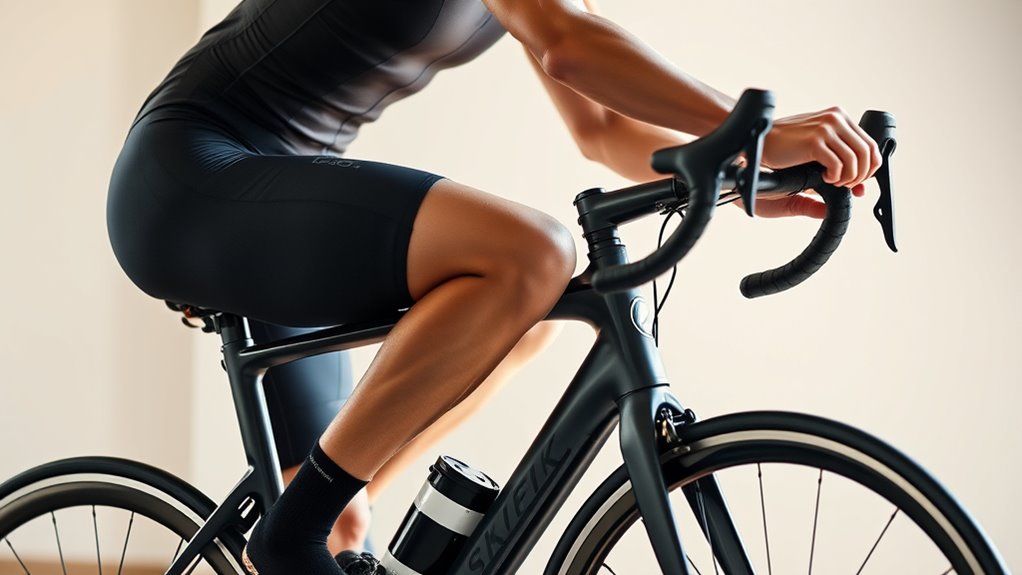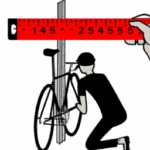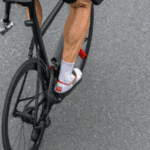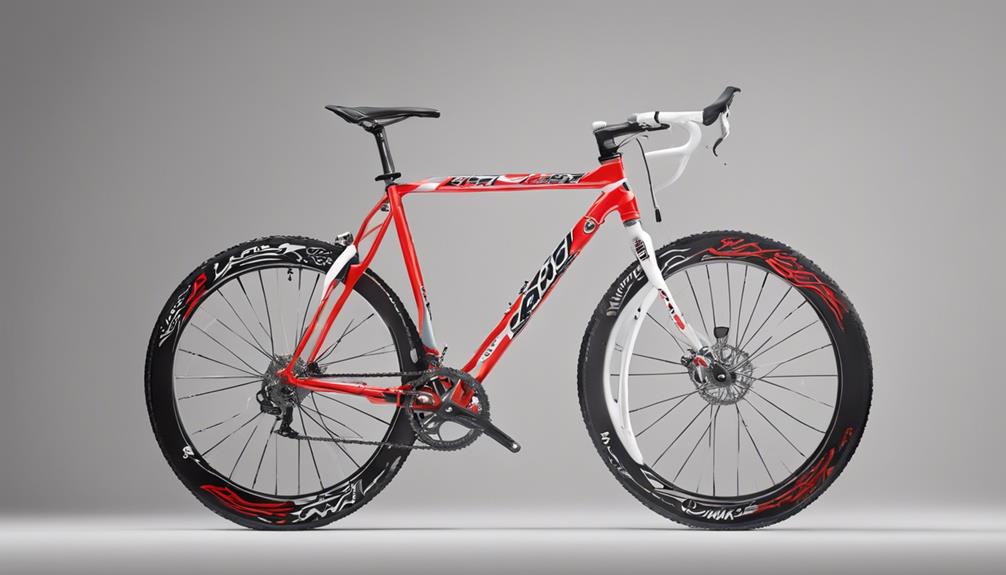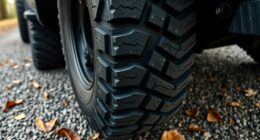A proper bike fit is essential for maximizing your comfort and boosting your cycling performance. When your saddle height, handlebar position, and pedal alignment are optimized, you reduce strain on joints, prevent injuries, and pedal more efficiently. This not only helps you ride longer and faster but also safeguards against overuse and discomfort. Keep in mind, tailoring your fit to your body and riding style makes a big difference—discover more ways to enhance your ride.
Key Takeaways
- Proper bike fit ensures contact points are optimized, enhancing comfort and reducing strain during rides.
- Correct saddle height and position prevent joint overextension and minimize injury risk.
- An optimal fit improves pedaling efficiency by aligning joints and activating muscle groups effectively.
- Adjustments to handlebar setup and saddle positioning promote better posture and reduce muscular fatigue.
- Regular bike fit reassessment helps maintain performance, prevent discomfort, and adapt to physical changes over time.
The Role of Proper Bike Fitting in Enhancing Comfort
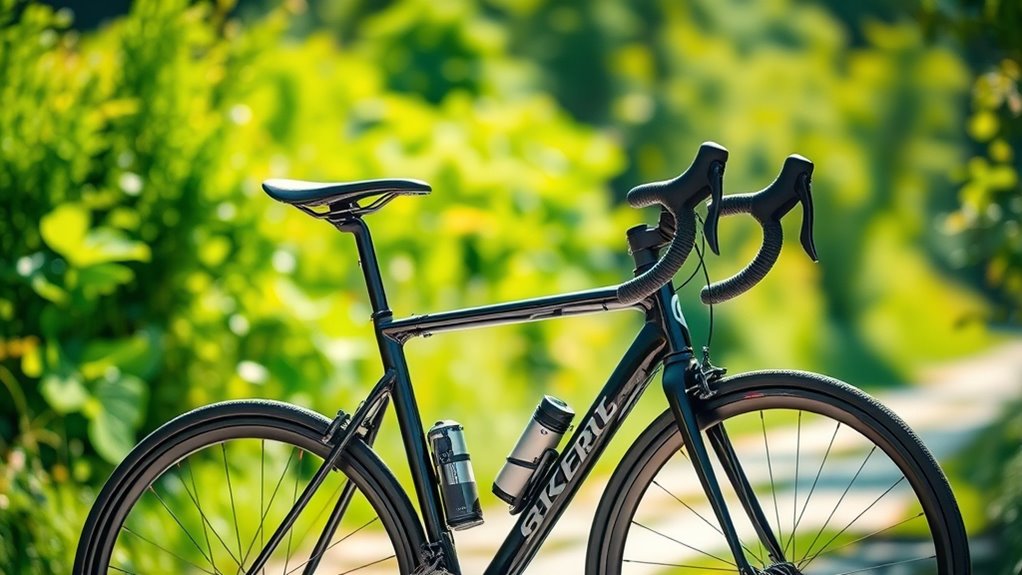
A proper bike fit plays a crucial role in enhancing your comfort during rides by guaranteeing that every contact point is optimized for your body. When your seat height is correct, it prevents knee strain by avoiding excessive extension or flexion, while proper knee-over-pedal spindle alignment boosts pedaling efficiency and reduces hip rocking. Additionally, incorporating smart home technology can help monitor and adjust your environment for optimal comfort during your ride or recovery periods. Adjusting the saddle fore and aft balances weight distribution between your hands and saddle, preventing muscle fatigue. Handlebar positioning, including width, stem length, and angle, improves breathing and reduces neck or shoulder tension. A well-fitted saddle, with appropriate tilt and width, supports your sit bones and alleviates soft-tissue stress. Fine-tuning the foot-pedal interface through cleat position and arch support ensures smooth pedaling and reduces joint stress, making your ride more comfortable and efficient.
How Correct Fit Prevents Common Cycling Injuries
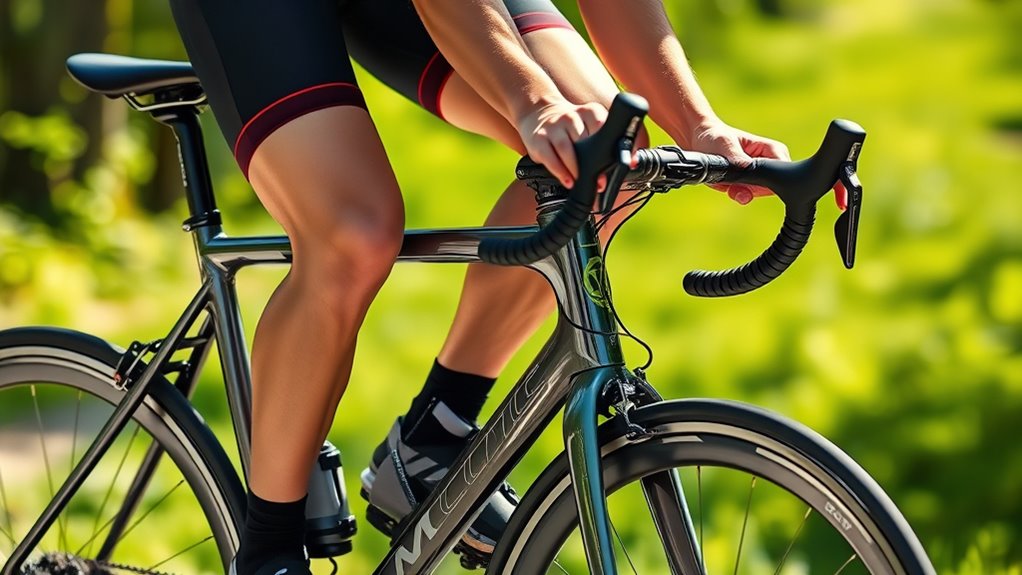
Ensuring your bike fits correctly is essential for preventing common cycling injuries. When your saddle height allows for a 20-30° knee bend at the pedal’s bottom, it stabilizes your knee joint and reduces stress on tendons and ligaments. Using the heel-to-pedal method guarantees correct saddle height, preventing overextension and tendonitis. Proper vertical alignment between the saddle and pedal minimizes patellofemoral pain. Adjusting the saddle fore-aft position balances knee-to-pedal distance for even force distribution. Gradually changing saddle height helps your musculoskeletal system adapt, avoiding sudden strain. Correct cleat positioning—aligned with your natural gait, with appropriate float and fore-aft placement—reduces overuse injuries, knee ligament strain, and muscular imbalances. These adjustments protect your knees, hips, and tendons from common cycling injuries. Additionally, choosing the right bike fit accessories can further enhance comfort and injury prevention during rides. Staying informed about cycling biomechanics can help you optimize your setup for both performance and safety. Incorporating proper tuning techniques can ensure your bike components work harmoniously, further reducing injury risks and improving ride quality. Proper bike maintenance, including regular adjustments, also plays a crucial role in injury prevention and maintaining optimal performance.
Impact of Bike Fit on Cycling Performance and Efficiency
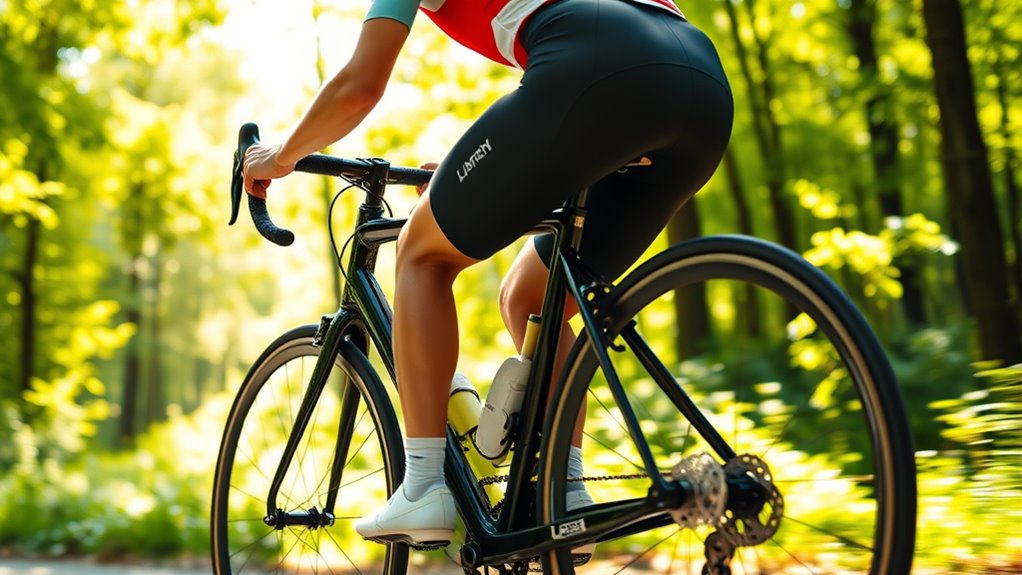
Optimizing your bike fit directly enhances cycling performance and efficiency by aligning your body mechanics with pedaling demands. When your joints are positioned for ideal angles, you waste less energy and transfer more force to the pedals.
Reduced lateral knee movement and proper hip-knee-ankle alignment ensure muscles activate smoothly, preventing energy loss from compensatory motions. Dynamic fitting systems like Retül fine-tune your biomechanics in real time, maximizing efficiency. Additionally, understanding the principles of performance tuning can help cyclists fine-tune their riding position for optimal results.
This improved alignment boosts gross efficiency at submaximal efforts and redistributes workload to larger muscle groups like glutes and quads, reducing oxygen consumption. Proper fit also enhances leverage through ideal crank length and balances power with aerodynamics.
Additionally, ensuring a correct bike fit can help minimize musculoskeletal injuries caused by improper positioning, contributing to longer, more comfortable rides.
Key Components Affected by Bike Fitting

The key components affected by bike fitting include saddle position, handlebar setup, pedal alignment, and overall rider biomechanics, all of which work together to influence comfort, power, and efficiency. Saddle adjustments—height, layback, and angle—directly impact pedaling efficiency and joint stability, while choosing the right saddle for your body reduces discomfort. Proper saddle fit not only enhances comfort but also helps prevent long-term joint issues. Ensuring correct saddle ergonomics is fundamental for a comfortable and injury-free ride. Handlebar reach, stem length, and width shape your riding posture, helping to prevent strain on your back, neck, and arms. Pedal positioning and crank length optimize your pedaling mechanics, maximizing power and reducing fatigue. Additionally, understanding your riding posture and how it relates to your body’s biomechanics can significantly improve your overall cycling experience. Finally, your overall biomechanics—such as hip, knee, and flexibility considerations—determine how well your bike fits your body, improving comfort and performance. Proper bike fit is essential for optimizing your riding experience and preventing injury. Proper modifications to these components ensure a smooth, efficient ride tailored to your physique.
Benefits of a Well-Adjusted Bike for Different Riders

A well-adjusted bike offers numerous benefits tailored to different riders’ needs, substantially enhancing comfort and safety. You’ll experience less pain and numbness in your hands, feet, and saddle area by reducing pressure points and correcting asymmetries, which helps prevent joint strain.
Proper adjustments improve your posture, reducing back and neck discomfort, and customizing saddle position addresses perineal pressure. Injury prevention is key—optimized biomechanics lower the risk of repetitive stress injuries and knee pain, while balanced muscle engagement avoids overuse issues.
It also boosts performance, increasing power output and pedaling efficiency, and reducing fatigue. Plus, a well-fitted bike adapts to changing needs, like flexibility or weight shifts, ensuring you stay comfortable and effective across different cycling activities and life stages.
Tailoring Bike Fit to Different Types of Cycling Activities
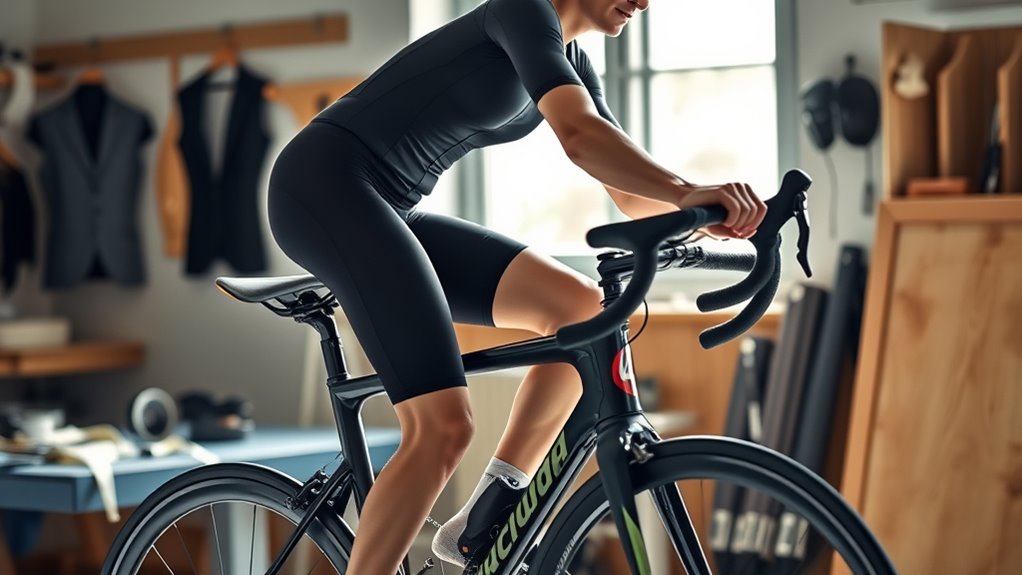
Different cycling activities demand tailored bike fits to maximize performance, comfort, and safety. For aero and triathlon bikes, precise forearm pad and saddle adjustments are critical to optimize aerodynamics and power transfer. The single hand position requires an exact fit to prevent neck and shoulder strain during long-distance races, with focus on cleat alignment, saddle tilt, and reach to aero bars.
Road and gravel bikes need flexible fit setups to accommodate multiple hand positions, handlebar width, stem length, and terrain demands. Gravel riders often prefer a slightly upright posture for technical handling.
Mountain bikes prioritize maneuverability, with shorter reach and higher handlebars, while commuter and hybrid bikes emphasize upright posture and comfort, with adjustments for cargo and urban riding.
Tailoring your bike fit to your specific activity enhances both performance and enjoyment.
Tips for Achieving and Maintaining the Ideal Bike Fit
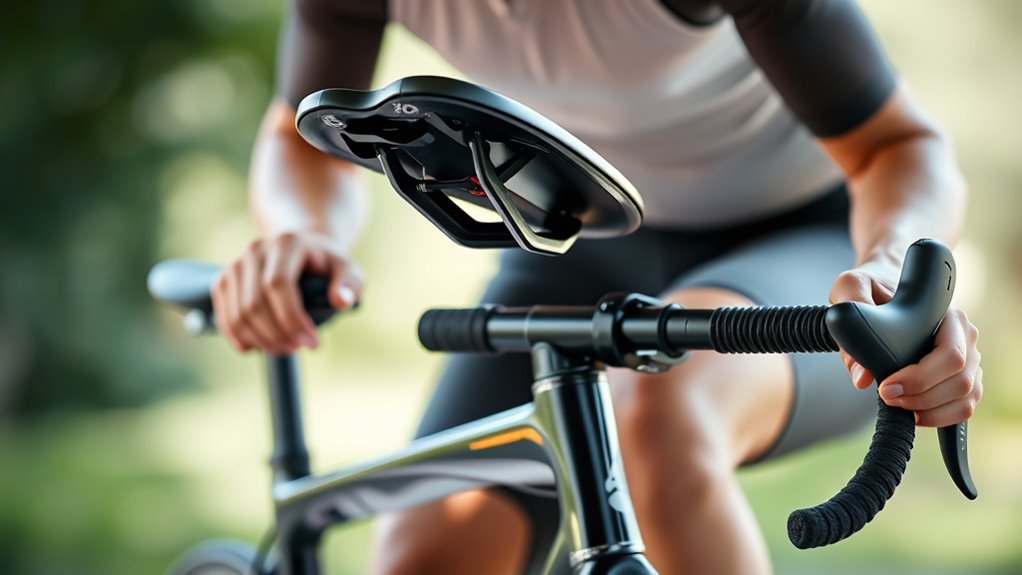
Achieving and maintaining the ideal bike fit requires paying close attention to key adjustments and regularly reassessing your setup.
Start by checking your frame size; you should be able to straddle the bike with both feet flat and a slight bend in your knees at the pedal’s lowest point.
Adjust your saddle height so your leg is almost straight when pedaling, and fine-tune its position for knee alignment.
Ensure your handlebar reach and drop suit your flexibility, with your back at about a 45-degree angle.
Regularly inspect cleat alignment to prevent knee pain and improve pedaling efficiency.
Don’t forget to review your position periodically, especially as your strength or flexibility change.
Small tweaks can make a significant difference in comfort and performance over time.
Frequently Asked Questions
How Often Should I Reassess My Bike Fit?
You should reevaluate your bike fit at least once a year for general maintenance.
If you experience significant physical changes like weight shifts, injuries, or flexibility issues, do it immediately.
Also, reassess after upgrading components, increasing training intensity, or noticing symptoms like numbness, pain, or discomfort.
Regular check-ins help ensure your comfort, prevent injuries, and optimize your performance, keeping your ride enjoyable and efficient.
Can Bike Fit Adjustments Improve My Cycling Endurance?
Yes, bike fit adjustments can definitely improve your cycling endurance. When your bike fits well, you pedal more efficiently, reducing fatigue and preventing discomfort or injury.
Proper cleat positioning, saddle height, and alignment ensure muscles work best, helping you ride longer without tiring quickly.
Advanced technology and expert guidance can fine-tune your setup, making each ride more comfortable and allowing you to sustain effort over extended distances.
What Signs Indicate My Bike Fit Needs Correction?
You might notice subtle signs that your bike fit isn’t right—like hand numbness, knee pain, or difficulty reaching controls. Maybe your saddle feels uncomfortable, or your hands tire quickly. These clues hint at misaligned components or improper positioning. Don’t ignore them.
Adjust your handlebar height, saddle position, or cleats. By catching these signals early, you’ll ride more comfortably and efficiently, preventing bigger issues down the road.
Does a Professional Bike Fitting Cost More Than DIY?
You’re asking if a professional bike fitting costs more than a DIY approach. Typically, professional fittings range from $75 to $500, depending on tools and techniques used.
DIY methods usually cost $0 to $75, relying on apps or basic measurements. So, yes, a professional fit generally costs more, but it offers personalized adjustments, advanced technology, and better long-term comfort and performance compared to DIY options.
Are There Specific Bike Fit Considerations for Different Riding Terrains?
When considering bike fit for different terrains, you should focus on handlebar width, saddle position, and stem length, which vary by terrain.
For road riding, keep a nearly horizontal saddle and narrow handlebars.
For gravel or mountain biking, opt for wider handlebars and adjustments for comfort.
Always tailor saddle width to your sit bones and guarantee proper knee alignment.
These adjustments help improve comfort and efficiency across diverse riding conditions.
Conclusion
Think of your bike as an extension of yourself—when it fits perfectly, it becomes your trusted partner, guiding you smoothly through every ride. A proper fit isn’t just about comfort; it’s about revealing your full potential and avoiding setbacks. When you align yourself with your bike, you’re steering toward a future of enjoyable, injury-free cycling. Embrace the right fit, and watch your passion for riding flourish like a well-tuned compass guiding you home.
